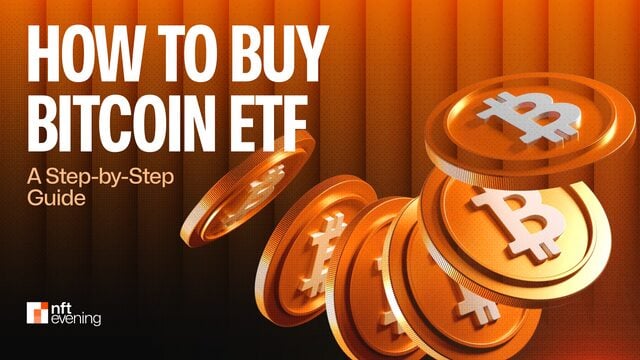“How to buy Bitcoin ETF” has become a pressing question for many investors seeking indirect exposure to the cryptocurrency market without grappling with the intricacies of wallets and private keys.
In this guide, we’ll cover the basics of bitcoin ETF investing, where to find these products, and how to execute a smooth purchase. While a Bitcoin ETF doesn’t hold actual Bitcoin in your wallet, it can still offer a convenient way to benefit from price swings.
Where to buy Bitcoin ETFs?
Most U.S.-based and international investors can purchase Bitcoin ETFs via mainstream brokerage platforms that list cryptocurrency-related products. Popular options include Charles Schwab, Fidelity, and E*TRADE, each offering user-friendly interfaces and in-depth research tools. When scanning potential brokerages, consider trading fees, regulatory developments, and ease of funding your account (through bank transfers or other payment methods).
For those outside the U.S., certain markets carry physically backed or futures-based ETFs with their own regional guidelines. Always confirm which type of underlying asset your chosen ETF holds. Some funds track futures contracts, while others aim to mirror the price of bitcoin.
How to buy Bitcoin ETFs
Step 1: Search for the ETF you want
Start by identifying which bitcoin futures or spot-oriented products suit your investment strategies. Different funds use various structures—some hold futures contracts, others track a basket of other assets—which can impact tracking accuracy. Review the ticker symbol, the fund’s method for replicating Bitcoin’s market price, and the net asset worth of its holdings.
Compare each ETF’s expense ratio, as higher fees can erode potential gains over time. Take a look at annual or quarterly performance data, bearing in mind that past performance is no guarantee of future results, especially in a highly volatile crypto marketplace.
Step 2: Open a brokerage account
Once you decide on a product, pick a brokerage that supports it. Popular brokerages in the U.S. include Schwab, Fidelity, and Robinhood, though not all list the same exchange-traded funds. After choosing a platform, open an account by providing identification and meeting regulatory oversight requirements.
Accounts covered by the SIPC offer investor protection of up to $500,000 for equities or ETF holdings, though crypto holdings outside these ETFs generally lack FDIC or SIPC coverage.
Step 3: Fund and Place Your Order
Deposit funds into your newly created brokerage account using a bank transfer or credit card if the platform allows it. Next, type in the ticker symbol of the Bitcoin ETF you want to buy, and choose between a market order (buy immediately at the prevailing price) or a limit order (specify a price below or above the current listing).
Step 4: Monitor Your ETF & Manage Risks
After execution, your ETF shares will show up in your account’s holdings, accessible for review in your portfolio summary. Keep a watchful eye on external factors like cryptocurrency prices or upcoming SEC announcements—regulatory developments can spark major shifts in the ETF’s performance. Because this product only grants indirect exposure rather than holding Bitcoin directly, you won’t be dealing with private keys or distributed ledger confirmations.
Compare Platforms for Investing in Bitcoin ETFs
Here we’ve broken down some of the specifics of each brokerage account, so you can compare them quickly and easily. Each platform features different fee structures, user interfaces, and regulatory coverage. Check which aligns with your investment goals, trading style, and regional availability.
Fees
User Experience
Regulatory Coverage
Notes
Schwab
Low/no commission on many ETF trades
Straightforward interface; robust tools
SIPC coverage; is well-established in US
Broad range of products, including crypto-related ETFs
Fidelity
Commission-free for certain ETFs
Intuitive web & mobile platform
SIPC insured; strong brand reputation
Wide investment options; decent research & educational content
E*TRADE
Usually $0 commission for ETF trading
Easy to navigate; moderate learning curve
SIPC insured; part of Morgan Stanley
Good for active traders; margin trading available
Interactive Brokers
Tiered/flat fees based on volume
More advanced interface, steep learning curve
SIPC insured; global market access
Ideal for experienced traders needing many markets & products
Robinhood
Commission-free trades
Very user-friendly, minimal research tool
SIPC coverage; target is retail US traders
Limited advanced features; watch out for potentially wider spreads
Pros & Cons of Bitcoin ETF
Pros
- Regulatory Framework: ETFs operate under established securities laws, giving investors a layer of oversight that pure crypto exchanges might lack.
- No Wallet Hassles: Owning an ETF spares you the complexity of managing private keys or encountering security breaches on crypto exchanges.
- Simple Integration: You can buy or sell shares in the same brokerage account you use for stocks or other assets, streamlining your overall portfolio management.
- Familiar Tax Treatment: ETF trades generally follow standard rules for capital gains and losses,



